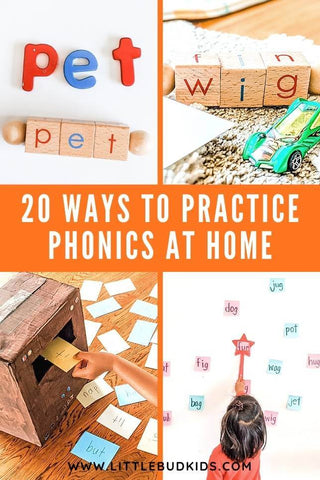20 Ways to Practice Phonics & Establish a Strong Reading Foundation

In this post, we want to share 20 phonics tips & ideas that you can easily implement at home! Hopefully you'll find the list helpful in guiding you towards providing an optimal environment for fostering strong, confident readers who want to read more and more...
Before we begin - here is a breakdown on some common phonic terms:
Phonics: the process of combining individual or group letter sounds together to make words. c + a + t = cat
Phoneme: the individual sound that a letter or group of letters make. The word cat has 3 phonemes: "c", "a", and "t"Decoding/Decodable words: using phonics to break down letter sounds in a word in order to read it.
Blending/blend it together: literally letting letter sounds connect together to make a whole word. gr+ee+n = green.
Letter sound: the actual sound a letter makes
Letter name: the name of a letter. As how we delineate it in the alphabet.
Digraphs: Two letters that make one sound. Such as "ph" in the word "phone" and "ch" in the word "chair"
Blends: Two consonants that blend together and make a sound whereby both letters can still be heard. Such as "bl" in "blue" and "cl" in "clear"
Short vowel sound: The sound a vowel (a e i o u) more often makes.
Long vowel sound: The sound a vowel (a e i o u) makes that sounds like its name.
Silent E: Words with a silent E include the letter E at the end, which changes the sound of the first vowel from a short vowel sound into a long vowel sound.
Now that you're a pro in phonics lingo, let's get started! The list below begins with simple tips for your younger beginner reader then progresses to more involved and advanced tips for your more advanced beginner reader. Buckle up, here are your 20 tips!
-
Teach the Letter Sounds First: If you haven't already taught your child the ABC song, it's highly recommended to introduce letters with their sounds, not names! This helps avoid confusion as to why a written letter sounds 2 different ways. For example, when helping your child recognize their name, sounding out the letter sounds is way more straightforward. Just look at the name "Bob." When we spell out the name "Bob" using the letter names, the name sounds do not match the actual sounds at all!
-
Give Them the Terms: If your child already names the letter names, but not the sounds, don't worry! Equip them and explain that letters are special because they have a name, but then they also have sounds! We find providing terminology to the child helps them understand the difference. Some helpful terms to use: the name of the letter, sound of the letter, ___ sounds like ____, put it together or blend it, break it apart, beginning sound, ending sound.
-
Read a Minimum of 15-20 Minutes a Day: Children should be read to daily for at least 15-20 minutes. Not only are you building a strong bond with your child through reading, but reading helps your child build vocabulary, work on listening and reading comprehension, broaden the imagination, and become more familiar with letters and words. Even if English is not your first language, let your child see you making the effort to read as they will be likewise motivated.
-
Read Alphabet-based Books: Alphabet-based books help children soak in letter sounds without making it seem like they are doing tedious learning. Sound out the letter sounds before completing a word. For example, if there's a picture of an apple - sound out the beginning letter sound - "a a apple."
-
Read Books with Real-life Images: Studies show that young babies and toddlers learn better from reality vs fantasy. Choose books that portray clear, beautiful, true-life pictures or real-life illustrations to give them the framework they need of the real world. Babies and young toddlers are naturally drawn towards real-life pictures vs fantasy-looking ones - yes, that includes pictures of a bear wearing glasses and clothes and riding a bike. And if your child holds more interest to a book because of the realistic images, well, then that's more opportunity to read.
-
Read Nursery Rhymes: No explanation for this one. Cause rhymes are naturally fun! Okay, in all seriousness. Why rhymes? Rhymes offer so many different learning opportunities. For instance, rhymes help children experience rhythm in the language; rhymes accentuate how different words with different meanings can sound similar because of a shared phoneme (sound), thereby introducing children to word families, digraphs, and blends - all components of learning phonics. For example: "The cat sat on the mat." Ask: Do you hear the rhyme? Do you hear how the words kind of all sound similar? That's because they all have the same ending "-at"!! C-at, s-at, m-at.
-
Beginning Sounds Object Collection: Pick a letter to focus on. Gather objects around your house that begin with that letter. Put it in a large basket or bucket. Then add to the bucket other objects that do NOT begin with that sound. Introduce the game and have your child sort out the objects that have the same beginning sound. Tip: This activity can expand to other letter-focused activities - let your child do the collection of objects or have themed activities, whether it's a worksheet or an arts & craft activity that is all about that letter. For example, if the letter focus is "B," an expanded activity could be an arts & craft time where your child writes the letter B using b b beans.
-
Beginning Sounds Game: Play a game where you and your child go back and forth saying words that start with the same letter. Model the method of saying the letter sound prior to the word: "b b blueberry." Do this in the car, in the bath, on a walk, or any time for that matter!
-
Beginning/ending Sounds Hop Scotch: Grab some chalk and head outside. Draw a series of circles/squares in a large oval. Call out a letter and have your child hop to it. For more advanced learners, call out a word and have your child hop to the correct first sound/letter of that word. Switch it up! Call out a word, and have your child hop to the ending sound/letter!
-
Vowel Hop: Let's incorporate some active learning again with this simple vowel sound check. Get 5 pieces of cardboard (cut up cereal boxes work great) and write 1 vowel on each. Put them in a circle. This activity starts out simple then gets more advanced. Have your child hop to the correct vowel: start with saying the vowel names, then the vowel sounds, then words with the short vowel sound, then words with the long vowel sound. You will see her brain churning as she translates the sounds she is hearing and applies them to the "marks" she sees on the cardboard.
-
Letter/picture Scavenger Hunt with Post-its: Can you tell I'm all about active learning + learning with material you already have at home? Take some picture flashcards or do a quick google search/get a magazine and print and cut out a collection of pictures. Write the beginning letter for each picture on a post-it. Paste the flashcards/pictures on the wall around your house. Give your child the collection of post-its and have her match the letter to the pictures! Burns some energy and makes learning into a game!
-
Letter/picture Match Obstacle Course: Choose 4 letters to focus on and get a collection of picture flashcards (with no written word) for those beginning letters. Write each letter on a large piece of paper and place around the room. Hand one card to your child at a time and have her bring the card to the correct beginning letter. Tip: Make it an obstacle course! Incorporate some type of maneuvering or action before or after dropping off the card. For example - jump over the books, go down the slide, do a jumping jack, hop to a spot, etc...
-
Magnetic Alphabet Letters Sound Match: Say the letter sound, let them find the correct letter! As with all the other activities, take this a step further - say a word, and have them find the correct letter; or have them do it all! Have them say a word and find the corresponding letter. If you do not already have a set of magnetic alphabet letters, get some. I don't usually like electronic toys, but I've found this set to be quite versatile in its use. However, having a set with multiple quantities of vowels is priceless, and we've found this set to fit the bill. Of course, if you are handy, you can get some magnetic letters and paint/gloss them yourself, in red (consonants) and blue (vowels).
-
Introduce the Movable Alphabet: Once your child has nailed down the sounds associated with each letter, it is time to introduce the movable alphabet. What is this? Grab some magnetic letters, or letters cut up in individual squares of papers, and put letters together to form a word. Move these individual letters around to see how dynamic word building is! If you have a pair of phonetic rotating blocks - use this together with the movable alphabet for more practice and tactile practice.

-
Start with Simple Word Families: Word families are essentially a collection of 2 or 3 letters that are often found together in the English language. They typically consist of a short vowel and a consonant. For example, -at is a word family and it includes many simple CVC words aka as consonant-vowel-consonant words such as cat, mat, hat, bat, pat, etc... Using your movable alphabet pieces, create a word family. Teach your child the sound this word family makes, showing him how to "blend" the letters together to make one complete sound. Then, add to the front of the word a letter that completes the word family. Let your child switch out the letters to create new words --and that, my friends, is the first step of your child reading!!
Tip: Don't have magnetic letters or not looking forward to the gzillion letter pieces from this activity, then check out our Little Bud Kids Spin-and-Read Phonetic Reading Blocks! Our Montessori-inspired spinning reading blocks provides all the tactile manipulation that a child needs to "wholly" learn and empowers her to feel absolutely in control of what she creates and reads. This phonics toy literally spins words to life AND comes with a set of heavy duty flashcards categorized by vowel and color; the cards offer self-corrective guidance through it's double-sided feature too!
-
I Spy, Phonics Edition: This game is kind of like Taboo, except the guesser can only ask yes or no questions.
Example:
Player 1: "I spy with my little eye something that has the -at word family." Player 2: Is it the hat?
Player 1: No.
Player 2: Is it alive?
Player 1: Yes.
Player 2: Is it the cat?
Player 1: Yes!
-
Word family/digraph/blend Dot Stickers Match: I LOVE dot stickers. Dot stickers can be used to create an infinite number of games and activities. For this phonics match, get a large piece of butcher paper (or several pieces of construction papers) and divide it up, selecting a collection of 4 phonic topics you've been working on. Here's an example of one I did with my daughter using 4 word families: at, -an, -ot, ig. I prepared a bunch of dot stickers and wrote a bunch of letters on them that could be used together with those word families. Her job was to stick a lettered dot sticker to the paper and come up with as many real words as she could.
Tip: This activity works on so many areas of development and can be expanded in so many different ways. We really like these dot stickers; unless you live near a stationery store, it'll be hard to find these at a Target or the Dollar Store, so we've found it easier to buy it off Amazon.
-
Magic E Magic: Once your child has mastered simple CVC short-vowel words, it is time to move on to more complex words that have digraphs and blends, and words with the silent magic E. A tip on making magic E learning more fun - get a special wand/stick to remind your child of how *magical* silent E is. Start with a CVC word in order to introduce the CVCe (the "e" is the magic E added on) word. An example would be: "tap". Add on the magic E at the end of "tap" using your movable alphabet to make the word "tape". Next, take your special pointer to point at the magic E and then point to the first vowel in the word and say, now magic E is going to make this vowel say its name! Now short vowel "tap" turns into long vowel "tape".
-
Hit/smack the Right Decodable Word: Practice makes better. And active learning makes practice enjoyable and not tedious. Remember how children learn best when they are physically interacting with the world and what they're learning? Write a collection of decodable words on post-its or a small pieces of paper. Find a blank wall and tape them up scattered on the wall. Use either a small, soft ball or get a fly swatter/pointer stick and start the game. Call out a word and have your child throw/point/slap the correct word. Leave the post-it up or take it down (depending how easy you want to make the game), and keep calling out each word. Tip: take this a step further: have your child tell you the word family or the phonics rule and make a sentence with that word.

- Mailbox Delivery: Cut a hole in the front of a sturdy cardboard box then let your child design their own mailbox. Let them make it special and let them take the lead. Kids love to "deliver" things and role play (if you don't have a cardboard box, even a large oatmeal container with a slit cut on the top of the lid works too!). Create a collection of letters, CVC words, or sight words (or whatever they are working on) and have them read/identify/describe/make a sentence for each letter. The possibilities are endless here and the role play definitely makes practice like a game!
-
Bonus Activity!! - Use Quizlet or Make Flashcards to Play Go Fish! or Memory: Create your own flashcards with the phonics lesson that your child is working on. Then play Go Fish! or Memory. Tip: Don't want to write out a bunch of flashcards? You can create your own flashcard sets for free at Quizlet.com and create a free account. Not only will you be able to print out the flashcards in different formats there, but Quizlet can also create a variety of games and activities for each flashcard set you create. I used this when I was teaching ESL and this website was so incredibly helpful.
There you have it!! I hope that you've found these tips helpful in letting phonics (and language) become a natural part of every day life. I am a big proponent of working with the materials you already have at home and upcycling them to a higher calling. You don't have to buy all the phonics material in the market to make a strong reader (although we believe our Little Bud Kids Spin-and-Read Blocks are worth it in gold 😄). However, if you think outside the box of how to "phonics" throughout the day, your child will be off to a great start.
Cheers!
~Emilia
p/s I would love to hear your thoughts below! Have you done any of these phonic activities with your child? Any other tips you've found helpful?


I appreciate you providing how to teach phonics in a simple way that I’m able to teach. I’m raising my granddaughter; she seems to have issues processing information and has been slow to learn. Thank you for providing teaching materials and helpful tips that enable me to help her learn.
I adore what you stated about how understanding phonics can help people understand why a written letter might sound in two distinct ways. My child has trouble pronouncing a few words. I’m looking for an online phonics learning program for my child. https://senseable.com/sensable-strategies/
Hello! My nephew’s daughter is turning five next week and I think I want to give something educational for her. I absolutely appreciate it when you pointed out that using flash cards with pictures can accelerate kids’ understanding about basic words and sentences. Hmm.. I guess I’ll consider this choice when I make a purchase pretty soon. https://debbible.com/product/new-2021-jolly-phonics-student-book-3-jl7243/
I love your tip about starting phonics with simple word families. I am raising a bilingual child so it’s a little difficult for her to grasp the English sounds. I think it would be nice to have a phonics book that I could use to teach her how to read certain sounds. https://fingertipbooks.net/order-materials/ols/products/explicit-systematic-teaching-of-phonics
Leave a comment